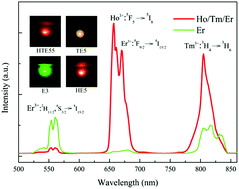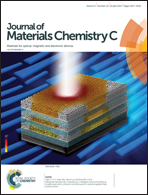Visible and near-infrared upconversion in α-sialon ceramics†
Abstract
α-Sialon ceramics are well known for highly stressed structural engineering applications owing to their inherently outstanding mechanical and thermo-chemical stability. However, the possibilities of the functional applications such as frequency upconversion in α-sialon ceramics have been scarcely investigated. Here, very intense visible and near-infrared frequency upconversion as well as frequency downconversion emissions are reported for the first time in Er3+, Ho3+, and Tm3+ triply doped α-sialon ceramics under 980 nm excitation. α-Sialon ceramics are prepared using a hot press sintering technique. Efficient energy transfer processes between the dopant ions are found to be responsible for the observed emissions. The upconversion process is governed by a two-photon absorption process. The energy transfer efficiency in the triply doped system is 95.8% while that in Er3+/Ho3+ and Er3+/Tm3+ systems is 71.6% and 66.3%, respectively. Triple doping results in the combination of the emission properties found in the co-doped Er3+/Ho3+ and Er3+/Tm3+ systems and it also reveals a cooperative emission behavior which is not possible with only two dopants. These findings open up the possibility of potential application of the Er3+/Ho3+/Tm3+ doped α-sialon ceramic as an optical material in which efficient luminescent properties can co-exist along with the excellent mechanical and thermo-chemical stability.



 Please wait while we load your content...
Please wait while we load your content...